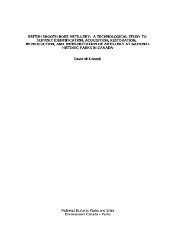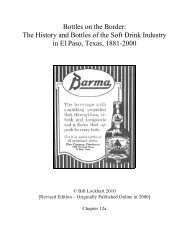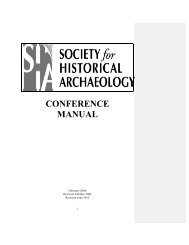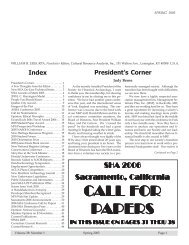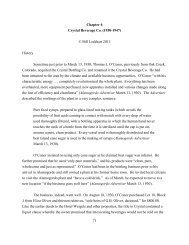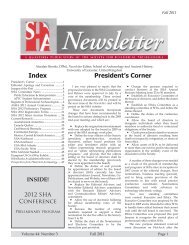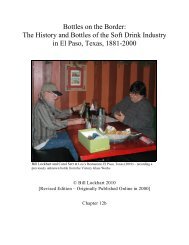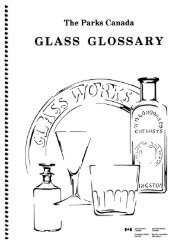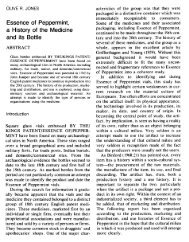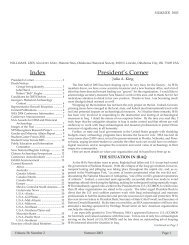Bottles on the Border: The History and Bottles of the Soft Drink ...
Bottles on the Border: The History and Bottles of the Soft Drink ...
Bottles on the Border: The History and Bottles of the Soft Drink ...
You also want an ePaper? Increase the reach of your titles
YUMPU automatically turns print PDFs into web optimized ePapers that Google loves.
Figure 5-4 – Houck & Dieter soda plant<br />
(Sanborn Fire Insurance Map 1883)<br />
<strong>The</strong> original warehouse was <strong>on</strong> San Francisco<br />
St., <strong>and</strong> <strong>the</strong> firm <strong>on</strong>ly sold beer <strong>and</strong> mineral water that<br />
came from outside <strong>the</strong> city. Originally, all bottled<br />
goods were brought by wag<strong>on</strong> from <strong>the</strong> end <strong>of</strong> track.<br />
According to <strong>the</strong> Times, “<strong>the</strong> first car load <strong>of</strong> beer<br />
was hauled by teams from <strong>the</strong> c<strong>on</strong>structi<strong>on</strong> camp [at]<br />
<strong>the</strong> ‘fr<strong>on</strong>t.’” <strong>The</strong> 1883 Sanborn Fire Insurance Map<br />
shows a “SODA WATER FAC” in a small building<br />
that was part <strong>of</strong> a complex <strong>on</strong> <strong>the</strong> corner <strong>of</strong> San<br />
Francisco <strong>and</strong> Chihuahua. <strong>The</strong> complex was built <strong>on</strong><br />
<strong>the</strong> Spanish design with rooms around a central<br />
courtyard. A salo<strong>on</strong> fr<strong>on</strong>ted <strong>on</strong> Chihuahua St. at <strong>the</strong><br />
corner with a dwelling extending from its side<br />
southward <strong>on</strong> Chihuahua. <strong>The</strong> soda water factory<br />
was <strong>on</strong> <strong>the</strong> sou<strong>the</strong>ast corner <strong>of</strong> <strong>the</strong> complex well <strong>of</strong>f-set from <strong>the</strong> street (Figure 5-4).<br />
Although Dieter was primarily interested in alcoholic beverages, he was farsighted<br />
enough to realize that <strong>the</strong> coming <strong>of</strong> <strong>the</strong> railroads meant an opportunity to fill <strong>the</strong> needs <strong>of</strong> a<br />
multitude <strong>of</strong> different thirsts. On April 1, 1881, less than two m<strong>on</strong>ths prior to <strong>the</strong> arrival <strong>of</strong> <strong>the</strong><br />
railroad <strong>and</strong> <strong>on</strong>ly two m<strong>on</strong>ths after <strong>the</strong>ir opening, <strong>the</strong> firm <strong>of</strong> Houck & Dieter launched its soda<br />
bottling establishment in El Paso. According to <strong>the</strong> El Paso Times, <strong>the</strong> new establishment was “a<br />
branch <strong>of</strong> A.L. Houck & Co., Santa Fe, New Mexico, <strong>the</strong> largest <strong>and</strong> most extensive wholesale<br />
beer <strong>and</strong> soda house in <strong>the</strong> territory.” Dieter managed <strong>the</strong> El Paso branch that <strong>the</strong> Times crowed<br />
was “<strong>the</strong> largest establishment west <strong>of</strong> Chicago, employing a large number <strong>of</strong> men” (EPT<br />
1/1/1882 2:3).<br />
Although <strong>the</strong> Times may have exaggerated, Houck & Dieter could rightfully claim a<br />
thriving business. <strong>The</strong> firm bottled Soda Water, Sarsaparilla, Royal Ginger Ale, Seltzer Water,<br />
Champagne Cider, <strong>and</strong> o<strong>the</strong>r carb<strong>on</strong>ated beverages. Royal Ginger Ale enjoyed a particularly<br />
good reputati<strong>on</strong> in early El Paso. In additi<strong>on</strong>, <strong>the</strong> firm distributed Appolinaris Water, Nassau<br />
Selter, Manitou Mineral water products, <strong>and</strong> Stafford Mineral Springs Water. <strong>The</strong> El Paso<br />
branch bottled five hundred dozen sodas a day, while <strong>the</strong>ir sec<strong>on</strong>d plant, across <strong>the</strong> Rio Gr<strong>and</strong>e<br />
in Paso del Norte (later called Juarez), Mexico, had a capacity for two hundred fifty bottles per<br />
73



